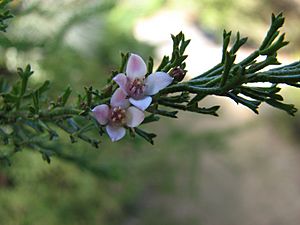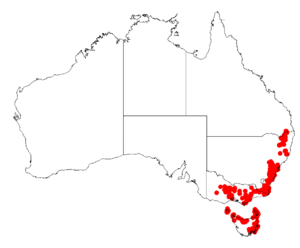Boronia anemonifolia facts for kids
Quick facts for kids Sticky boronia |
|
|---|---|
 |
|
| Boronia anemonifolia in Maranoa Gardens | |
| Scientific classification | |
 |
|
| Occurrence data from Australasian Virtual Herbarium |
Boronia anemonifolia, often called narrow-leaved boronia or sticky boronia, is a type of flowering plant. It grows naturally only in south-eastern Australia. This plant is a shrub with leaves that usually have many small parts, like a feather. It produces lovely white to pale pink flowers, each with four petals. These flowers grow where the leaves join the stem.
What Does Sticky Boronia Look Like?
Boronia anemonifolia is a shrub that stands upright. It can grow up to about 2.5 meters (8 feet) tall. Its branches often have small, bumpy spots called glands.
The leaves usually have many small parts, like a feather. Sometimes, they are simple or even double-feathered. They are typically 4 to 18 millimeters (0.16 to 0.71 inches) long and 2 to 25 millimeters (0.08 to 0.98 inches) wide. Each leaf has a stalk, usually 2 to 9 millimeters (0.08 to 0.35 inches) long. The small leaf parts are often shaped like a wedge, oval, or egg. They are mostly 2 to 9 millimeters (0.08 to 0.35 inches) long and 1 to 4 millimeters (0.04 to 0.16 inches) wide. Both sides of the leaf are the same color. The tip of the leaf often has three small points.
The flowers are white to pale pink. They grow alone or in small groups of up to nine flowers. Each flower sits on a small stalk, 1 to 8 millimeters (0.04 to 0.31 inches) long. The plant has four sepals, which are like small leaves that protect the flower bud. These sepals are broadly egg-shaped, about 1.5 to 2.5 millimeters (0.06 to 0.10 inches) long. The four petals are 4 to 6 millimeters (0.16 to 0.24 inches) long. Their bases overlap each other. There are eight stamens, which are the parts that produce pollen.
This plant flowers from August to April. After flowering, it produces a smooth, dry fruit called a capsule. This capsule is 3 to 5 millimeters (0.12 to 0.20 inches) long and about 2 millimeters (0.08 inches) wide.
How Was Sticky Boronia Named?
The plant Boronia anemonifolia was first officially described in 1825. This was done by a botanist named Allan Cunningham. He published his description in a book called Geographical Memoirs on New South Wales.
The second part of its scientific name, anemonifolia, means "anemone-leaved". This is because its leaves look a bit like the leaves of plants in the Anemone genus.
In 2000, two scientists, Peter Neish and Marco Duretto, identified four different types, or subspecies, of B. anemonifolia. These subspecies are now recognized by the Australian Plant Census. They are:
- Boronia anemonifolia subsp. anemonifolia
- Boronia anemonifolia subsp. aurifodina
- Boronia anemonifolia subsp. variabilis
- Boronia anemonifolia subsp. wadbilligensis
Where Does Sticky Boronia Grow?
Each subspecies of sticky boronia grows in slightly different places across south-eastern Australia.
- Subspecies anemonifolia likes to grow in woodlands and heathlands. You can often find it on rocky areas along the coast and nearby tablelands. It grows from near Rylstone in New South Wales down to the Brisbane Ranges in Victoria.
- Subspecies aurifodina grows in low, open eucalypt woodlands. It is found in only a few areas in central Victoria.
- Subspecies variabilis is the most common and widespread type. It grows in heath, open woodland, or open forest. You can find it in south-east Queensland, along the coast and ranges of New South Wales, and in northern and south-eastern Tasmania. In Victoria, it only grows on two islands near Wilsons Promontory.
- Subspecies wadbilligensis grows in eucalypt woodland or low heath on rocky areas. It is only found on the Wadbilliga plateau in New South Wales.

